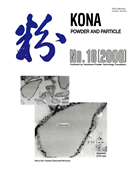Volume 18
Displaying 1-35 of 35 articles from this issue
- |<
- <
- 1
- >
- >|
Front Cover
-
2000 Volume 18 Pages Cover18_1
Published: 2000
Released on J-STAGE: May 30, 2014
Download PDF (246K) -
2000 Volume 18 Pages EdBrd18_1
Published: 2000
Released on J-STAGE: May 30, 2014
Download PDF (710K)
Obitaury
-
2000 Volume 18 Pages 1-2
Published: 2000
Released on J-STAGE: May 30, 2014
Download PDF (153K)
The Letter from the Editor
-
2000 Volume 18 Pages 3
Published: 2000
Released on J-STAGE: May 30, 2014
Download PDF (90K)
GENERAL INFORMATION
-
2000 Volume 18 Pages 4
Published: 2000
Released on J-STAGE: May 30, 2014
Download PDF (122K)
Explanation of the Cover Photograph
-
2000 Volume 18 Pages 7
Published: 2000
Released on J-STAGE: May 30, 2014
Download PDF (91K)
Review
-
2000 Volume 18 Pages 9-19
Published: 2000
Released on J-STAGE: May 30, 2014
Download PDF (821K) -
2000 Volume 18 Pages 20-25
Published: 2000
Released on J-STAGE: May 30, 2014
Download PDF (441K) -
2000 Volume 18 Pages 26-40
Published: 2000
Released on J-STAGE: May 30, 2014
Download PDF (977K)
Original Research Paper
-
2000 Volume 18 Pages 41-59
Published: 2000
Released on J-STAGE: May 30, 2014
Download PDF (1427K) -
2000 Volume 18 Pages 60-65
Published: 2000
Released on J-STAGE: May 30, 2014
Download PDF (477K) -
2000 Volume 18 Pages 66-73
Published: 2000
Released on J-STAGE: May 30, 2014
Download PDF (552K) -
2000 Volume 18 Pages 74-80
Published: 2000
Released on J-STAGE: May 30, 2014
Download PDF (579K) -
2000 Volume 18 Pages 81-87
Published: 2000
Released on J-STAGE: May 30, 2014
Download PDF (490K) -
2000 Volume 18 Pages 88-101
Published: 2000
Released on J-STAGE: May 30, 2014
Download PDF (876K) -
2000 Volume 18 Pages 102-107
Published: 2000
Released on J-STAGE: May 30, 2014
Download PDF (408K) -
2000 Volume 18 Pages 108-120
Published: 2000
Released on J-STAGE: May 30, 2014
Download PDF (1004K) -
2000 Volume 18 Pages 121-130
Published: 2000
Released on J-STAGE: May 30, 2014
Download PDF (697K) -
2000 Volume 18 Pages 131-138
Published: 2000
Released on J-STAGE: May 30, 2014
Download PDF (538K) -
2000 Volume 18 Pages 139-148
Published: 2000
Released on J-STAGE: May 30, 2014
Download PDF (755K) -
2000 Volume 18 Pages 149-156
Published: 2000
Released on J-STAGE: May 30, 2014
Download PDF (532K) -
2000 Volume 18 Pages 157-169
Published: 2000
Released on J-STAGE: May 30, 2014
Download PDF (808K) -
2000 Volume 18 Pages 170-182
Published: 2000
Released on J-STAGE: May 30, 2014
Download PDF (1104K) -
2000 Volume 18 Pages 183-193
Published: 2000
Released on J-STAGE: May 30, 2014
Download PDF (808K)
Translated Research Paper
-
2000 Volume 18 Pages 194-199
Published: 2000
Released on J-STAGE: May 30, 2014
Download PDF (430K) -
2000 Volume 18 Pages 200-206
Published: 2000
Released on J-STAGE: May 30, 2014
Download PDF (444K) -
2000 Volume 18 Pages 207-212
Published: 2000
Released on J-STAGE: May 30, 2014
Download PDF (437K) -
2000 Volume 18 Pages 213-220
Published: 2000
Released on J-STAGE: May 30, 2014
Download PDF (536K) -
2000 Volume 18 Pages 221-229
Published: 2000
Released on J-STAGE: May 30, 2014
Download PDF (574K) -
2000 Volume 18 Pages 230-235
Published: 2000
Released on J-STAGE: May 30, 2014
Download PDF (409K) -
2000 Volume 18 Pages 236-241
Published: 2000
Released on J-STAGE: May 30, 2014
Download PDF (429K)
Information Articles
-
2000 Volume 18 Pages 242
Published: 2000
Released on J-STAGE: May 30, 2014
Download PDF (146K) -
2000 Volume 18 Pages 243
Published: 2000
Released on J-STAGE: May 30, 2014
Download PDF (98K)
Academic publication concerning powder technology in Japan
-
2000 Volume 18 Pages 244-246
Published: 2000
Released on J-STAGE: May 30, 2014
Download PDF (205K)
New Product News
-
2000 Volume 18 Pages 247-249
Published: 2000
Released on J-STAGE: May 30, 2014
Download PDF (725K)
- |<
- <
- 1
- >
- >|
